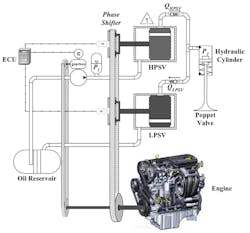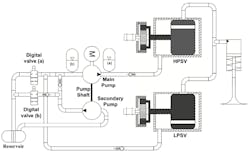While the engineering community continues to explore the benefits of electric and hybrid vehicles—i.e., the environmental and renewable energy factors—the automotive market is still dependent on traditional gas engines. And in an attempt to keep them competitive with electric, researchers are looking to improve gasoline engine efficiency.
After a decade of research, the engineering team at the University of Waterloo led by Amir Khajepour, a professor of mechanical and mechatronics engineering, has developed a variable valve actuation system (VVA) that looks to improve engine efficiency by 10%.
The Problems of Cam-Based and Camless Systems
Intake and exhaust valves in internal combustion engines are typically controlled by cam mechanisms—either cam-based or camless systems. The cam-based systems are driven by an engine crankshaft. Many modern-day vehicles have cam-based systems due to their high reliability, accuracy, and robustness. Cam-phasers and cam-profile switchers are two well-known technologies found in cam-based systems. These valvetrain systems have a low level of flexibility, as cam mechanisms do not allow the timing of their opening and closing to be varied.
Camless systems are completely disconnected from the engine crankshaft. They offer high levels of flexibility in valve timing and valve lift. Electro-hydraulic, electro-mechanical, electro-pneumatic, and electro-magnetic valve trains all fit in the camless category. These systems suffer from high cost, high power consumption, low robustness, and low reliability.
What is a VVA System?
Schematic of the proposed VVA. HPSV = High pressure rotary spool valve. LPSV = low pressure rotary spool valve. (Image credit: Waterloo University)
The new VVA system developed by the team at Waterloo looks to solve the issues of both cam-based and camless systems. The ability to time the exact opening and closing of valves according to engine operation is essential to increase fuel efficiency, reducing both costs and greenhouse gas emissions.
The team’s design is a hydraulic-based system that precisely controls the engine valve timings, opening duration, and lift. It replaces the cams with hydraulic cylinders and rotary hydraulic valves that enable fully variable timing as the speed and torque of an engine change.
The system has been equipped with linear and non-linear controllers. It uses an energy recovery technique to remove the trade-off that exists between the system’s power consumption and sensitivity. The optimized system has a low variability of about 5% (0.5 mm) to cycle-to-cycle variations of 50% in the in-cylinder gas force. The proposed energy recovery system (ERS) also consumes about 58% of the energy used in a conventional cam-driven valvetrain.
The proposed ERS for VVA system. (Image credit: Waterloo University)
The system has two rotary spool valves, two phase shifters, a single-acting spring-return hydraulic actuator for each engine valve, and a hydraulic power unit. The engine valve is connected to the hydraulic actuator piston. There are low-pressure and high-pressure rotary spool valves that are responsible for transferring oil to or from the hydraulic cylinder. The valves are rotated by the crankshaft and the engine speed is two times larger in four-stroke engines.
The two-phase shifters are electric to shift their shafts independently. With respect to their original position, the phase shifters are able to change the angular position of the output shaft without changing the input/output speed ratio.
The hydraulic system is used to guarantee a full closure of the engine valve at the maximum engine speed. The hydraulic system causes the engine valve to close early at lower engine speeds. During the closing stage at lower engine speeds, only part of the spring’s potential energy is used to empty the cylinder by discharging the oil, while the rest goes to waste.
To conserve the spring’s excess potential energy during the valve’s closing stage, the upstream pressure of the main pump is able to be changed by a secondary pump coupled to the shaft of the main pump. The downstream pressure of the engine valve actuator is regulated in such a way that the surplus spring energy maintains the main pump’s upstream pressure during engine valve operation. This reduces the power consumption of the main pump.
Variable valve actuation systems do exist, but only in laboratory settings, and they are costly and complex. The system developed by Waterloo is simpler and less expensive, which has significant potential for power generation, mining vehicles, the trucking industry, and a host of other applications—including the consumer automotive market.
“This method has the potential to bring the well-established benefits of a fully variable valve system out of the lab and into production engines, because cost and complexity aren’t issues,” Khajepour says.



